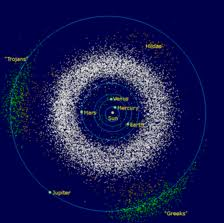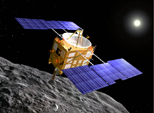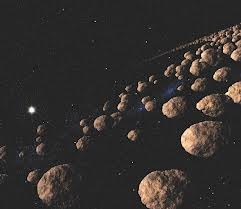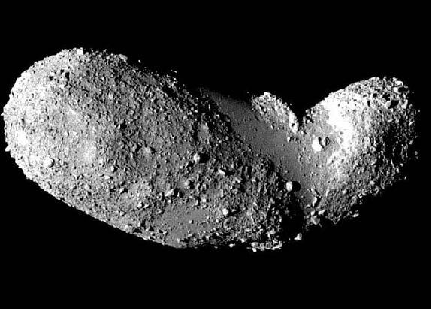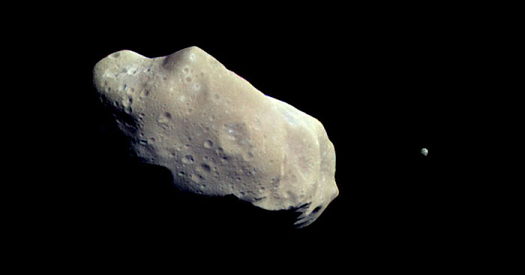Also known as the main belt, the asteroid belt is a region located between the orbits of Mars and Jupiter. Most of the asteroids in the solar system orbit the sun in this area.
The Asteroid Belt Image Source
Various Spacecrafts Have Explored the Asteroid Belt
Although no human has ever flew by or landed on an asteroid, there have been several missions to explore the asteroid belt as follows:
In 1991, NASA’s Galileospacecraft flew over asteroids Gaspra and Ida. In 1993, NEAR-Shoemaker explored Mathilde and Eros. Other missions include the Deep Space 1 and Stardust.
In 2005 the Japanese spacecraft Hayabusa became the first spacecraft to land on an asteroid, collect samples, take off and return to earth successfully.
Japanese spacecraft Hayabusa Image Source
Currently, NASA’s Dawn mission which launched in 2007 is headed to the asteroid belt to orbit and explore Vesta and Ceres, which are also referred to as baby planets. Astronomers hope to learn more about the conditions of the early solar system by studying these two bodies.
The Discovery of the Asteroid Belt
The discovery of the Asteroid Belt began in the 18th century when Johann Titius, an astronomer, noticed that there is a mathematical pattern in the way the planets are laid out in the solar system. From this formula, he was able to predict that there should have been a planet between Mars and Jupiter.
Johann Titius Image Source
Astronomers began the search for this planet and discovered Ceres, Pallas and many more objects occupying a circular region between the orbits of Mars and Jupiter. These objects were too small to be classified as planets and so they were named asteroids.
How Did The Asteroid Belt Form?
Astronomers believe that this belt formed shortly after the birth of the solar system. Rocks, dust particles and other materials orbiting the sun were pulled by the planets’ gravitational force and become a part of these planets.
It is believed that this belt had so many objects that if combined would have formed a planet four times larger than Earth. However, Jupiter the largest planet with an extremely high gravity pull prevented some of these objects from coming together and forming planets. These objects collided with each other and formed the asteroids orbiting the sun.
Why Is the Asteroid Belt Also Known as The Main Belt?
The asteroid belt is referred to as the main belt to differentiate it from other belts that exist in the solar system. These other belts are the Kuiper Belt and the scattered disc.
What Is In The Asteroid Belt?
The asteroid belt is like a circular highway and its objects are like vehicles. Majority of the asteroids in the solar system are found here. There are millions of known asteroids and scientists estimate trillions of them exist.
These objects are made up of different materials depending on how far or how close to the sun they formed. Asteroids are made up of rocky pieces covered in dust. Others are a pile of rubble stuck together while some are metallic. Others are a mixture of stones, rocks, metals and carbon materials. The most distant asteroids also contain ice. Comets are made up of icy particles, which are believed to be melting.
The objects within this region are not concentrated in one area. They are spread over a large area. It is even possible for spacecrafts to travel through the belt without colliding with an object. However, the asteroids sometimes collide and merge or break into pieces.
The Asteroid Belt Objects Image Source
Is There A Risk of Asteroids Hitting Earth?
Some asteroids stray away from the main belt and some of them fall on earth. However, these are not considered a threat to life. Almost once every year, vehicle-sized asteroids enter the earth’s atmosphere, light up and disintegrate before hitting the surface.
How Large Are The Asteroids in The Asteroid Belt?
Ceres is the largest asteroid at 952km/592 miles in diameter and is considered a dwarf planet. More than 16 objects in this belt have a diameter that exceeds 150 miles/240 km. Some asteroids are less than 1km/0.6miles in diameter. The largest asteroids in this belt are Vesta, Pallas and Hygeia.
What Are Asteroids?
Asteroids are small, rocky objects made up of remnants from the formation of the solar system. Sometimes, they are referred to as minor planets. Most of the asteroids in the solar system are found in a region between the orbits of Mars and Jupiter where they orbit the sun. They also rotate on their own axis some of them in an erratic manner that makes them tumble.
Why are Asteroids of Interest to Astronomers?
Since the birth of the solar system, most of the planets and other bodies have undergone a lot of changes in their structure and composition. Asteroids are an exception in this case. They have not changed much in composition except for the collisions that modifies their structure. There are still composed of remnants of the early solar system. Their study could provide more information about the formation of the solar system.
How Do Asteroids Look Like?
Most of the asteroids have an irregular shape that is pitted and cratered. Some of them have a spherical shape.
The Asteroid Itokawa composed of a pile of rubble hung together Image source: Space
Are There Moons in The Asteroid Belt?
About 150 of the asteroids in the main belt have a small moon with a few of them having two. Some asteroids are composed of two or three rocky bodies almost the same size orbiting each other and these are known as double or triple asteroid systems.
Asteroid Ida (left) and its moon Dactyl (right) Image Source: NASA
What Are Near Earth Objects?
Near Earth Objects refers to asteroids whose path intersect earth’s orbit. Scientists use observations and radar to monitor these objects that could fall on earth.
Did An Asteroid Lead To Dinosaur Extinction?
It is believed that a massive asteroid or comet fell on earth and contributed to the extinction of dinosaurs millions of years ago.

